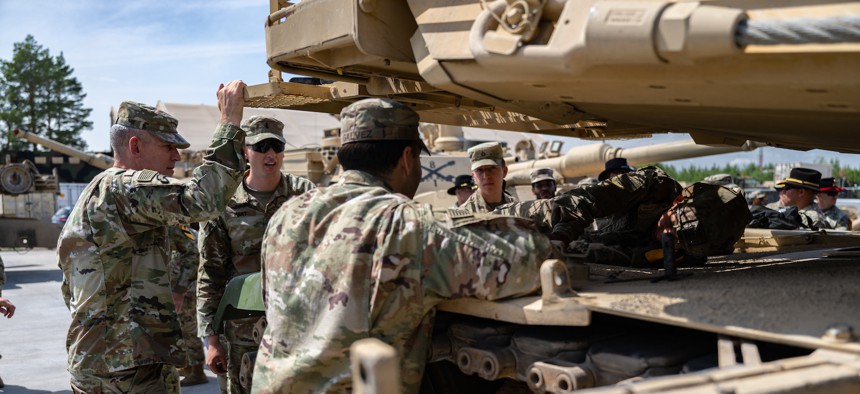
Maj. Gen. David Doyle, commanding general of the 4th Infantry Division, is briefed on M1A2 Abrams operations by armor officer 1st Lt. Eoin Hart during a visitation near Pabrade, Lithuania, on June 23, 2023. U.S. Army / Staff Sgt. Cesar Rivas
In the 4th Infantry Division, soldiers are cooking up homebrew data tools
And the commanding general is running courses to help others build more.
Army aviators juggle a lot of information to make sure their helicopters are ready to fight. So the 4th Combat Aviation Brigade recently coded up a tool to help.
“They've got a maintenance program of record that gives them good information. They've got the mission program of record that tells them what they're supposed to train. They've got the funding line of effort that tells them how much they can spend,” said Maj. Gen. David Doyle, who leads the Army’s 4th Infantry Division, to which the aviation brigade belongs. “And by doing just a little bit of coding work, they can pull those different programs of record and give a commander a clear decision, or at least a chance to say ‘this is the sequence in which we do our mission’.”
By taking “existing tools that are free and on the market and then writing just a little bit of code,” the 4th CAB produced a new tool that “scrapes information out of the program record and lets us see it in a more clear way,” Doyle said.
Now Doyle is working to spread this kind of creative, do-it-yourself data processing throughout his division.
Earlier this month, the 4th ID held the first of a planned series of data-literacy workshops. About 200 soldiers and Army civilians, including lieutenant colonels with graduate degrees in data management, came to Ft. Carson, Colo. on Nov. 30 and Dec.1 to talk about how their units use data, what problems they face, and how they might solve them. The division’s brigade deployed in Korea also joined virtually.
The workshop was led by Schuyler Moore, the chief technology officer of U.S. Central Command, which has become known for its own efforts to use more digital tools.
“Data literacy is such a tricky topic,” Moore said via email. “Skills and knowledge requirements can vary significantly from organization to organization.”
Moore said CENTCOM reviews its own data-training program and tools every six months to keep up with organizational needs.
“Across DOD, we have to invest in tools that make data analytics and visualization accessible to everyone,” she wrote. “We also have to empower the population that we have, many of whom do not have technical skill sets (and realistically don’t need them for most of their jobs)...by giving them tools that allow them to use their data better, without requiring them to have a data science or computer science degree.”
Indeed, the Army Data Plan, released by the service CIO in October 2022, calls upon soldiers to help create a fighting force “fueled by data and data analytics.” The service also recently published its first doctrine focused solely on using data in combat.
But it will take more than policy documents to produce data-savvy troops, Doyle said.
“We have to figure out how to make it useful for the soldiers that are doing it on a day-to-day basis,” he said.
So in the new year, his 4th Infantry Division is planning to offer three eight-month, data-focused education seminars on data culture and talent management, analytics, and multi-domain operations. Attendees—typically officers, sergeants major, and non-commissioned officers—will be duty-assigned to Ft. Carson for the duration of the course.
In the meantime, the 4th CAB is testing and using its new tool, and aims eventually to distribute it to similar units. The hope is to inspire other communities in the division to come up with creative ways to use data.
“If this thing is productive and helps the commander, we want to share it. We want to give it to other aviation units to say, ‘Hey, this might work for you’,” Doyle said. “But there's always the risk that you make some judgments based on the data that are not consistent with your experience and intuition and years you've spent doing something. So we're trying to make sure that we validate it before we start executing off of it exclusively.”
Aviators aren’t the only 4th ID soldiers trying out new data tools. To tackle the Army’s directive for improving soldiers’ quality of life, 1st Stryker Brigade Combat Team took “a regression model and formulated it with incidents of harmful behavior” using historical data to predict future trends, Doyle said.
“What they found using the regression model is that if you get to a certain number, the inclination…was much higher for subsequent serious incident reports to materialize because something else bad is gonna happen,” he said.
A serious incident report covers things like suicide, threats, child abuse, vandalism, and theft of personal information.
Doyle said that the model doesn’t predict exactly what will happen, but helps commanders “recognize where there may be more risks” and when additional tools, resources, or investigations may be needed.
Since it was introduced two months ago, he said, the model has helped junior leaders, who have less experience, to intervene sooner.
“And in each case where they have applied resources, in each case where they have put more energy into the system, not surprisingly, they've seen lower incidences in the subsequent months,” Doyle said.
He noted that there are a lot of variables that make direct linkage difficult. Still, the experience is promising.
“It's really early days for us, but if you look at industry…they've been using these types of tools. We just have to adapt them a little bit so they produce results for us. I'm excited.”


